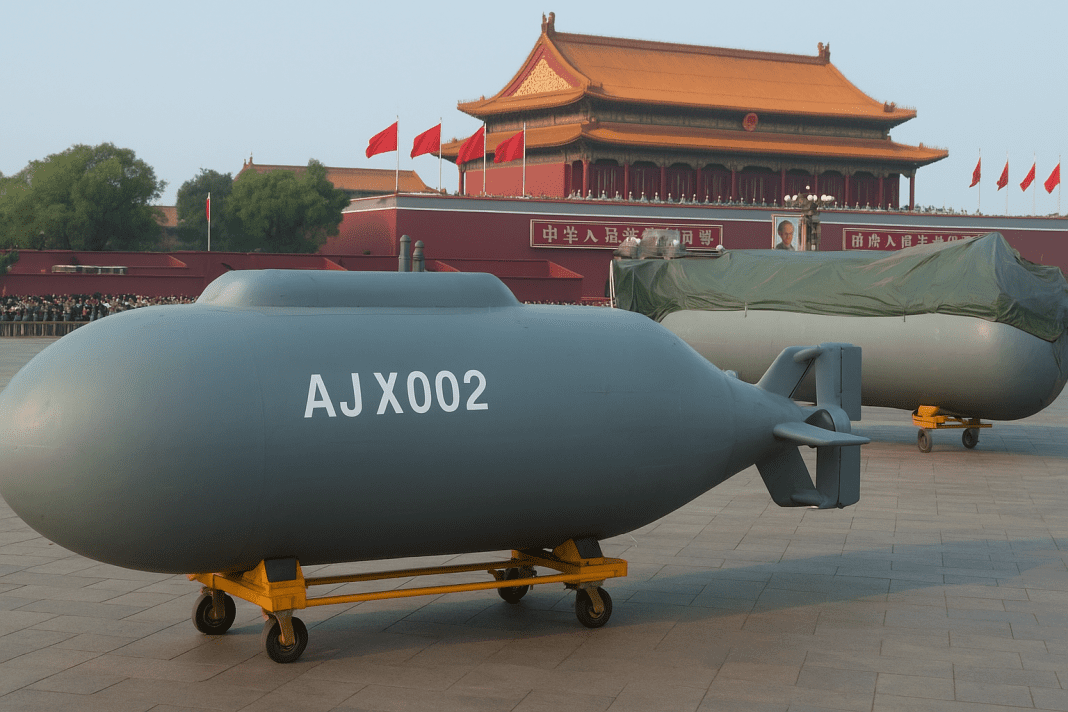China is putting its undersea ambitions on full display. On September 3, during a major military parade in Beijing, the country will reveal giant Chinese drone subs. These subs, called extra-large uncrewed underwater vehicles (XLUUVs), will appear for the first time in public as part of the 80th anniversary of the end of the Second Sino-Japanese War.
Chinese drone subs on parade to showcase undersea power
Reports suggest that China has rehearsed at least six of these massive underwater drones for the parade. The sight of them rolling past Tiananmen Square signals China’s rapid progress in undersea drone technology.
One model, named AJX002, measures about 18–20 meters long. It uses a pump-jet for movement and includes modular features that make transport easier. Observers spotted another larger design covered with a tarpaulin, but its stern structure and rudder shape indicate a different kind of build. Together, these designs show that China is testing more than one approach to this new class of underwater vehicle.
Submarine Shockwave: China’s JL-3 Missile Breakthrough Raises Alarms in U.S. and India
China’s Ministry of National Defense announced that the parade will highlight “improved weapons and equipment.” By choosing to display Chinese drone subs, the country shows its focus on expanding undersea warfare abilities. These vehicles could one day challenge US and allied surveillance networks spread across the Pacific Ocean.
The Fish Hook defense line
For decades, the United States and its allies have operated an extensive undersea surveillance network in the Pacific. This network is often called the “Fish Hook.” It is a chain of seabed sensors and fixed arrays designed to detect and track submarines.
The Fish Hook starts near Japan’s southern islands, stretches down through Okinawa and Taiwan, then runs toward the Philippines, Indonesia, and the Andaman Islands. Key stations also exist in places like Guam. Together, this system allows the US and its allies to closely watch submarine movement between the East China Sea, the South China Sea, and the wider Pacific.
Philippines May Acquire First “Attack Submarine” Amid Rising Tensions with China
The purpose of this network is clear: to keep Chinese submarines under constant observation. Even with modern upgrades, China’s submarine fleet still faces a high chance of being detected. The US Navy and its partners combine seabed sensors with satellites, aircraft, and unmanned surface or underwater vehicles to follow submarines from port to patrol areas. This widespread monitoring reduces the ability of Chinese submarines to remain hidden, which is considered the key advantage of undersea warfare.
Because of this, China sees the Fish Hook as a major obstacle. The new Chinese drone subs are being linked to possible plans to weaken or disable parts of the network. By targeting the sensors, cables, or repair ships, these underwater drones could complicate the ability of the US and allies to maintain constant awareness.
How Chinese drone subs fit into strategy
China has around 60 submarines, supported by a large industrial base that can produce new vessels faster than most other countries. However, building submarines does not solve the problem if foreign surveillance constantly tracks them. This is where the giant Chinese drone subs step in.
Extra-large uncrewed underwater vehicles operate without a crew. Operators can send them on long missions, sometimes lasting weeks or months, without direct control. Forces can use them to scout, lay mines, or attack undersea infrastructure. In this case, they mainly strike at the seabed surveillance system.
Possible methods include cutting undersea cables, planting explosives near key nodes, or creating interference that makes it harder for sensors to function. Unlike smaller drones, these giant versions have the size and endurance to carry heavy equipment and operate far from China’s coast.
If these systems are used effectively, they could reduce the reach of the Fish Hook. This would give China’s crewed submarines more room to operate undetected. That could strengthen their ability to support a naval blockade near Taiwan, place mines in shipping lanes, or patrol further into the Pacific.
$368 billion mistake? Growing fears AUKUS submarine deal could sink Australia’s sovereignty
China also operates nuclear-powered ballistic missile submarines, which carry long-range missiles. Currently, China keeps these submarines mostly in the South China Sea as part of a bastion strategy. They remain within a protected zone where ships, planes, and artificial islands guard them. However, their missile range limits their reach, and their small patrol area allows others to track them more easily. If weakened surveillance systems left gaps, these submarines could attempt broader patrols in the Pacific.
Despite China’s advances, the US and its allies still have large anti-submarine warfare (ASW) forces. Countries like India and Australia are expanding patrols and coastal radar systems. Even so, regional reports highlight that gaps in undersea monitoring remain, especially given the sheer size of the Pacific.
The introduction of Chinese drone subs reflects a growing competition beneath the waves. With China showcasing its unmanned underwater fleet, the focus now turns to how these machines might shape the balance of power in the Pacific’s ongoing silent struggle.

